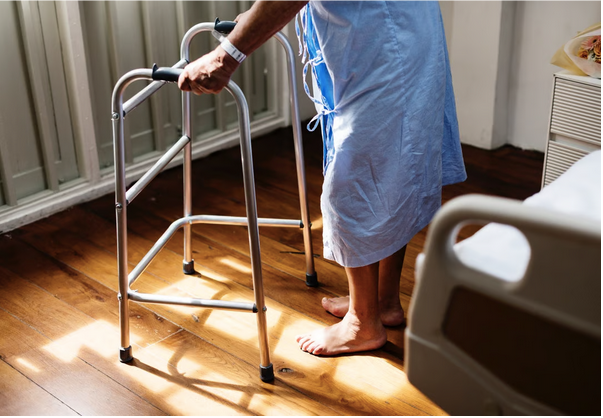Undergoing hip surgery is a significant event that necessitates not just physical recovery but also adjustments to your living environment to ensure safety, comfort, and a smoother healing process. Post-surgery, navigating around your home can become a challenge, making it imperative to create an accessible and supportive space. In this guide, we've compiled 6 expert tips to help you modify your home for easy access and promote an environment conducive to healing and independence. Whether it's minor adjustments or more substantial changes, these recommendations aim to empower you to reclaim your freedom and mobility within your own abode.

1. Ensure Safe Footpaths
Keeping your footpaths clear of any obstacles is crucial to avoid trips and falls, which can severely impact your recovery. Ensure that all walkways within your home are wide enough to accommodate a walker or crutches, and remove any hazards such as loose rugs, electrical cords, or clutter that could potentially obstruct your path. Opting for non-slip mats in critical areas, like the bathroom and kitchen, can further safeguard against slips. By prioritizing a clear and secure path, you create a safer environment that supports your mobility and fosters confidence as you navigate through your healing journey.
2. Consider Home Lift Installation
For multiple-story homes, stairs can present a daunting challenge after hip surgery. Installing a home lift can significantly ease this challenge. Considering a home lift installation can be a game-changer, especially when such services are provided by the Local Authority to help install homelifts, which ensures safe and efficient access to different levels of your property without the strain of using the stairs. Home lifts have become more compact, affordable, and aesthetically pleasing, making them a feasible option for many. Not only does a lift facilitate mobility and independence, but it also adds value to your home. Consulting with a professional to assess your space and understand the installation process can help you determine the best solution for your needs.
3. Adjust Bathroom Accessibility
The bathroom is one area that often requires significant modification post-hip surgery to ensure safety and comfort. Installing grab bars near the toilet and shower area is a fundamental step, providing the necessary support you need to stand or sit safely, thus preventing accidents. Additionally, consider incorporating a shower chair and a hand-held shower head to facilitate bathing without the risk of slipping, a common concern in post-surgical recovery. Raising the toilet seat can also make a considerable difference in comfort and safety, reducing the strain on your hip when sitting down or standing up. These thoughtful modifications can greatly enhance safety and independence in the bathroom, transforming it into a less daunting space to navigate and ensuring a smoother, more secure recovery process.
4. Revise Kitchen Layout for Reachability
In the kitchen, ensuring that everyday items are within easy reach is essential to prevent overexertion and maintain a safe environment, especially after surgery. It's important to place commonly used utensils, dishes, and food items on lower shelves and counters to minimize the need to stretch or bend, which can be detrimental to your recovery. Investing in a grabber tool can also be a game-changer, allowing you to retrieve items that are out of arm's reach without requiring risky movements. Making these strategic adjustments in the kitchen not only helps minimize the risk of injury but also makes cooking and meal preparation more accessible and enjoyable, supporting your independence during recovery.
5. Modify Bedroom for Comfort and Accessibility
Your bedroom should serve as a sanctuary where you can rest comfortably and recover in peace. It's crucial to ensure that your bed is at a height that makes it easy to get in and out without straining your hip, which might mean adjusting your bed's height or considering a bed rail for added support. Additionally, keeping essential items like your phone, a water bottle, and medications within easy reach of your bed can significantly reduce the need to move around excessively. Simple adjustments like these can transform your bedroom into a more comfortable and convenient recovery space, allowing for a smoother and more restful recovery period.
6. Equip Yourself with Mobility Aids
Equipping yourself with the right mobility aids is crucial for navigating your home and the outside world safely and effectively during your recovery. It's essential to consult with your healthcare provider to determine the most suitable mobility aids for your specific needs, which may include crutches, a walker, or a cane, depending on your mobility level and recovery progress. Having a sturdy chair with armrests in key areas of your home can also be incredibly beneficial, enabling you to take sitting breaks as needed without compromising your safety. Learning to use these aids properly not only significantly enhances your independence and confidence but also plays a crucial role in preventing falls and injuries, facilitating a more secure and efficient recovery process.

Adapting your home following hip surgery is a pivotal step toward a safe, comfortable, and efficient recovery. By implementing these six expert tips, from ensuring clear footpaths to strategically modifying key areas of your home like the bathroom, kitchen, and bedroom, you create an environment that supports healing and independence. Equipping yourself with essential mobility aids and making adjustments to promote accessibility not only aids in navigating daily life more easily but also significantly reduces the risk of injury. Remember, the goal of these changes is to foster an environment where recovery is not just possible but is also encouraged in every corner of your living space. With thoughtful planning and adjustments, you can enjoy a smoother transition to normalcy, ultimately regaining your freedom and mobility within the comfort of your home.
